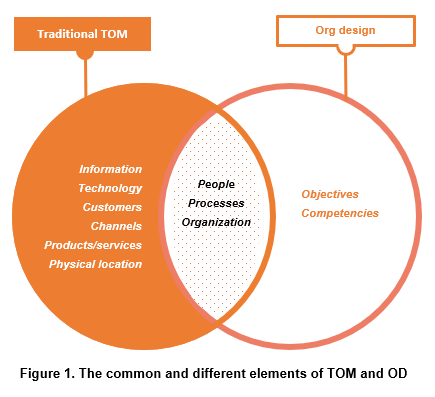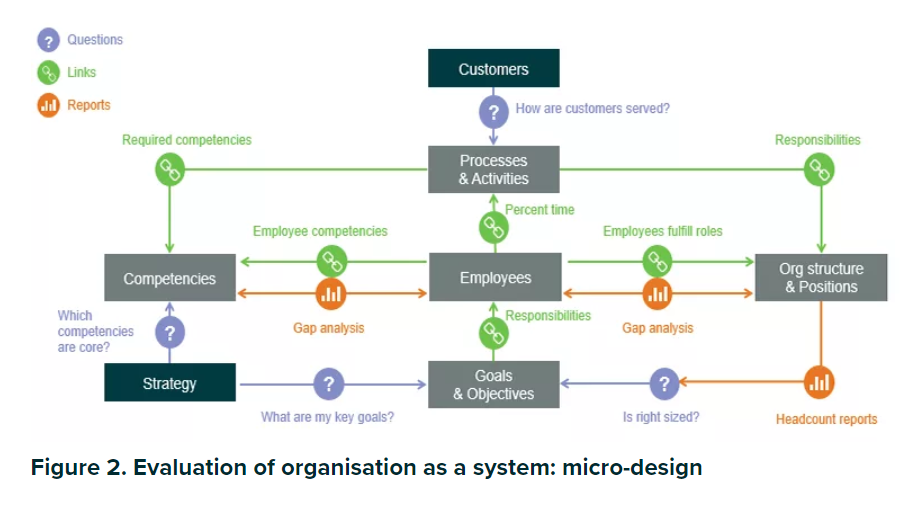What is the difference between target operating model and organizational design?
In this article, Rupert Morrison looks at what each means, how they relate to each other, and how you should use them.
[This article was updated on Aug 24, 2023]
Confusion and debate surround these two common industry terms. Is it better to use one and not the other, are they complementary concepts or simply different names for the same things? In this article, Rupert Morrison looks at what each means, how they relate to each other, and how you should use them.
I am often asked what the difference is between target operating model (TOM) and organizational structure design. I tend to find that while target operating model is generally well understood, there’s a lack of consensus among academics, HR practitioners, HR generalists, and those outside the HR function when it comes to a working definition of organizational design. Many people still think of org design as an exercise in changing the structure of an organizational chart. It’s so much more than that!
Why is it so important to be clear about these definitions? Rhetoric and pedantry aside, confusion in terminology and scope of these two concepts can cause the significant value they promise to deliver to be overlooked.
| Aspect | Target Operating Model (TOM) | Organizational Design (OD) |
| Definition | Comprehensive model enabling business strategy implementation | Shaping organizational structure to align with strategy |
| Focus | Delivery blueprint for business model | Micro-level design for achieving strategy and vision |
| Components | People, processes, organization, information, technology, customers, channels, products/services, physical location | Organizing people, work, goals, objectives, competencies, roles |
| Scope | Specifies what needs to be done for operating model success | Focuses on maximizing goal achievement and strategic alignment |
| Relationship to Strategy | Implements business strategy | Aligns people, processes, and competencies with strategy |
| Connection to Transformation | Part of the TOM and undertaken concurrently | Part of the transformation journey alongside TOM |
| Implementation Complexity | Addresses macro-level elements | Addresses micro-level details for goal achievement |
| Usage Consistency Recommendation | Choose either TOM or OD and use it consistently | Clarity in vision and basics is more important than the route |
What is target operating model?
By and large, there is consistency and structure in how target operating model, or TOM, is understood in a business context. KPMG, IBM, and Deloitte all define it as a comprehensive model that enables the implementation of business strategy.
An operating model breaks down the working parts that make up an organizational system and describes how a business delivers value. A commonly used way to describe these components is people, process, and organization. In other words, TOM is the blueprint for how a business will deliver its value proposition and profit model. It specifies what the organization needs to do for the operating model to achieve its objectives.
How to design a target operating model
When designing the target operating model, there are nine constituent parts that must be addressed (see Figure 1). These are:
- People: your workforce, its competencies and capabilities
- Processes: value chain and activities
- Organization: structure, layers, and spans of control
- Information: workforce, operational, and financial data
- Technology: software and systems
- Customers: market segmentation
- Channels: routes to market
- Products/services: innovation and time to market
- Physical location: where you operate offices or facilities
Breaking down a company’s current operating model into these elements makes it easier for business leaders to assess the maturity of their company’s current operation, define their desired future state, and design the roadmap to get to this state. This makes target operating model both a noun and a verb – a desired future state and the process of getting there.

What is organizational structure and design?
By contrast, organizational design (OD) is fundamentally about shaping an organization’s structure to align people, processes, and competencies with business strategy and objectives.
To make the distinction clear, I think about org design as a question: How do we organize people and work to maximise the probability of hitting our goals to deliver the strategy and achieve the organization’s vision.
The target operating model only provides the delivery blueprint for a company’s business model, whereas organizational design deconstructs the model, focusing on the granular level of how to ‘Make it Real’ (see Figure 2 and Figure 3). It gets into the micro-level design that includes goals and objectives as well as competencies and roles.
To understand our thinking on org design in more detail, download this introductory chapter from our book on data-driven organizational design.
Common Misconceptions
Misconception 1: TOM and OD Are Interchangeable
Many assume that TOM and OD are just different names for the same process. This is not the case. TOM refers to a future-state description of how a business aims to operate across processes, people, and technology to achieve its goals. It is more about the “what” and the “how” of operational aspects. OD, on the other hand, is focused on improving organizational effectiveness and employee well-being. It’s more concerned with the “who” and the “why” behind organizational change.
Misconception 2: TOM Is Just About Cost-Saving
While cost efficiency is a component of TOM, it encompasses much more. It’s about aligning an organization’s operating model with its strategic objectives, which can also include improving service quality, enhancing customer experience, and fostering innovation.
Misconception 3: OD Is Only About Team-Building Exercises
OD does involve team development, but it’s not limited to that. It’s a systematic approach for implementing change across an organization, focusing on culture, processes, and structures to improve organizational health and effectiveness.
Success Stories in TOM and OD Implementation
Example 1: Amazon’s Transformation through TOM
Amazon stands as a prime example of an organization adeptly realizing its Target Operating Model. This retail giant has meticulously crafted a highly efficient ecosystem encompassing warehouses, logistics and customer service frameworks, all contributing to its hallmark consistency in performance. Amazon’s strategic execution of TOM has empowered it to offer a diverse array of services at competitive rates, all the while sustaining elevated levels of customer satisfaction. For those seeking to understand the intricacies of an effective TOM, Amazon’s model offers profound insights.
Example 2: Mayo Clinic Embraces Excellence through TOM and OD
In the realm of healthcare, the Mayo Clinic emerges as a distinguished model, one that numerous healthcare service providers aspire to emulate. Renowned for its integrated, patient-centric approach, the Mayo Clinic has set a benchmark in delivering high-caliber care, markedly enhancing patient outcomes and satisfaction. What sets the Mayo Clinic apart is not just its exceptional patient care but also its ability to meld this with operational efficiency and cost-effectiveness. This dual achievement of superior healthcare delivery coupled with mindful management of operational expenses positions the Mayo Clinic as an ideal TOM and OD for healthcare organizations aiming to excel in both patient care and operational prudence.
Where OD meets TOM
Org design should be thought of as a part of the TOM and should be undertaken at the same time during any transformation project. The diagram below shows the interconnection of an organization’s elements at a micro level.

Choose one and stick with it
Much confusion has been caused by professionals using both TOM and OD in a project. In the academic context, both are simply different pathways to the same end goal: to move the organization to its future state. I would recommend you choose one concept and use it consistently.
Regardless of which you choose, you must be sure to drill down to the micro details and define all elements of the organizational system, so that your company vision is implementable and sustainable.
The ideal transformation journey would address all 11 elements shown on Figure 1. But in practice, you can’t do everything at once without putting your organization into cognitive overload and under unnecessary time pressure. You’ll need to decide which of the 11 elements to prioritize, in what order, and to what level of detail.
In the end, being clear on what you want to achieve with your macro design and getting the basics right is more important than the route you take to get there.
Challenges in Implementation
Overcoming Obstacles in TOM and OD
Resistance to Change: One of the biggest challenges in implementing TOM and OD is resistance from employees and managers. Changes in processes, technologies, and roles can lead to uncertainty and skepticism.
Cultural Barriers: Cultural alignment is crucial for the success of TOM and OD initiatives. Misalignment between the organization’s culture and the new changes can hinder the implementation process.
Aligning Strategies with Structures: For TOM, aligning the new operating model with the organization’s strategic goals can be challenging. Similarly, for OD, ensuring that the developmental strategies are in sync with organizational structures and processes is critical.
Measuring Success
Evaluating TOM and OD Initiatives
Key Performance Indicators (KPIs): For TOM, success can be measured through KPIs such as operational efficiency, cost savings, customer satisfaction and time-to-market for new products or services. In OD, employee engagement scores, turnover rates, and productivity metrics are valuable indicators.
Feedback and Surveys: Regular feedback from employees, managers, and customers can provide qualitative insights into the effectiveness of TOM and OD initiatives.
Benchmarking Against Goals: Comparing the post-implementation results with the original goals of the TOM or OD initiative can provide a clear picture of its success. Understanding the nuances of TOM and OD, learning from industry examples, navigating the challenges, and effectively measuring success are key to leveraging these models for organizational excellence.
References
- Deloitte (2009) Managing Complex Transformations: Achieving Excellence. Available at: http://www2.deloitte.com/content/dam/Deloitte/global/Documents/Energy-and-Resources/dttl-er-managingcomplextransformations-08082013.pdf (Accessed: 27 November 2015).
- IBM (2012) Target operating model accelerator. Available at: http://www-01.ibm.com/common/ssi/cgi-bin/ssialias?htmlfid=GBD03161USEN&appname=wwwsearch (Accessed: 27 November 2015).
- KPMG (2013) Target operating model. Available at: http://www.kpmg.com/in/en/services/advisory/performance-technology/itas/pages/targetoperatingmodel.aspx (Accessed: 27 November 2015).